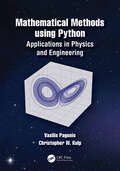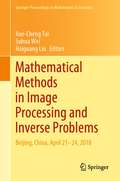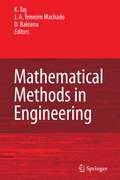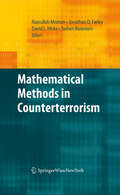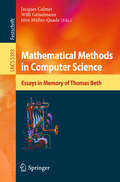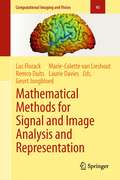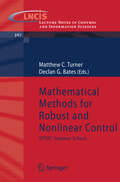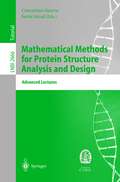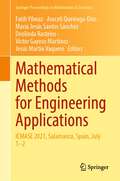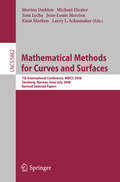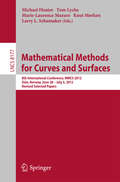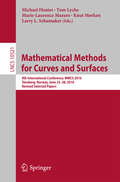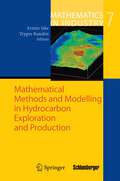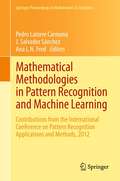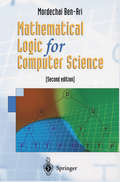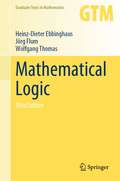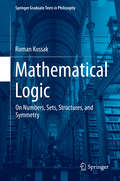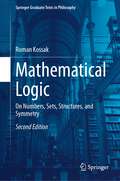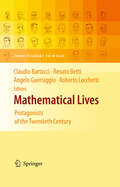- Table View
- List View
Mathematical Modeling: Problems, Methods, Applications
by Ludmilla A. Uvarova Anatolii V. LatyshevThis volume contains review articles and original results obtained in various fields of modern science using mathematical simulation methods. The basis of the articles are the plenary and some section reports that were made and discussed at the Fourth International Mathematical Simulation Conference, held in Moscow on June 27 through July 1, 2000. The conference was devoted to the following scientific areas: • mathematical and computer discrete systems models; • non-linear excitation in condensed media; • complex systems evolution; • mathematical models in economics; • non-equilibrium processes kinematics; • dynamics and structure of the molecular and biomolecular systems; • mathematical transfer models in non-linear systems; • numerical simulation and algorithms; • turbulence and determined chaos; • chemical physics of polymer. This conference was supported by the Russian Ministry of Education, Russian foundation for Basic Research and Federal Program "Integration". This volume contains the following sections: 1. models of non-linear phenomena in physics; 2. numerical methods and computer simulations; 3. mathematical computer models of discrete systems; 4. mathematical models in economics; 5. non-linear models in chemical physics and physical chemistry; 6. mathematical models of transport processes in complex systems. In Sections One and Five a number of fundamental and sufficiently general problems, concerning real physical and physical-chemical systems simulation, is discussed.
Mathematical Methods using Python: Applications in Physics and Engineering
by Vasilis Pagonis Christopher Wayne KulpThis advanced undergraduate textbook presents a new approach to teaching mathematical methods for scientists and engineers. It provides a practical, pedagogical introduction to utilizing Python in Mathematical and Computational Methods courses. Both analytical and computational examples are integrated from its start. Each chapter concludes with a set of problems designed to help students hone their skills in mathematical techniques, computer programming, and numerical analysis. The book places less emphasis on mathematical proofs, and more emphasis on how to use computers for both symbolic and numerical calculations. It contains 182 extensively documented coding examples, based on topics that students will encounter in their advanced courses in Mechanics, Electronics, Optics, Electromagnetism, Quantum Mechanics etc.An introductory chapter gives students a crash course in Python programming and the most often used libraries (SymPy, NumPy, SciPy, Matplotlib). This is followed by chapters dedicated to differentiation, integration, vectors and multiple integration techniques. The next group of chapters covers complex numbers, matrices, vector analysis and vector spaces. Extensive chapters cover ordinary and partial differential equations, followed by chapters on nonlinear systems and on the analysis of experimental data using linear and nonlinear regression techniques, Fourier transforms, binomial and Gaussian distributions. The book is accompanied by a dedicated GitHub website, which contains all codes from the book in the form of ready to run Jupyter notebooks. A detailed solutions manual is also available for instructors using the textbook in their courses.Key Features:· A unique teaching approach which merges mathematical methods and the Python programming skills which physicists and engineering students need in their courses.· Uses examples and models from physical and engineering systems, to motivate the mathematics being taught.· Students learn to solve scientific problems in three different ways: traditional pen-and-paper methods, using scientific numerical techniques with NumPy and SciPy, and using Symbolic Python (SymPy).Vasilis Pagonis is Professor of Physics Emeritus at McDaniel College, Maryland, USA. His research area is applications of thermally and optically stimulated luminescence. He taught courses in mathematical physics, classical and quantum mechanics, analog and digital electronics and numerous general science courses. Dr. Pagonis’ resume lists more than 200 peer-reviewed publications in international journals. He is currently associate editor of the journal Radiation Measurements. He is co-author with Christopher Kulp of the undergraduate textbook “Classical Mechanics: a computational approach, with examples in Python and Mathematica” (CRC Press, 2020). He has also co-authored four graduate-level textbooks in the field of luminescence dosimetry, and most recently published the book “Luminescence Signal analysis using Python” (Springer, 2022).Christopher Kulp is the John P. Graham Teaching Professor of Physics at Lycoming College. He has been teaching undergraduate physics at all levels for 20 years. Dr. Kulp’s research focuses on modelling complex systems, time series analysis, and machine learning. He has published 30 peer-reviewed papers in international journals, many of which include student co-authors. He is also co-author of the undergraduate textbook “Classical Mechanics: a computational approach, with examples in Python and Mathematica” (CRC Press, 2020).
Mathematical Methods using Python: Applications in Physics and Engineering
by Vasilis Pagonis Christopher Wayne KulpThis advanced undergraduate textbook presents a new approach to teaching mathematical methods for scientists and engineers. It provides a practical, pedagogical introduction to utilizing Python in Mathematical and Computational Methods courses. Both analytical and computational examples are integrated from its start. Each chapter concludes with a set of problems designed to help students hone their skills in mathematical techniques, computer programming, and numerical analysis. The book places less emphasis on mathematical proofs, and more emphasis on how to use computers for both symbolic and numerical calculations. It contains 182 extensively documented coding examples, based on topics that students will encounter in their advanced courses in Mechanics, Electronics, Optics, Electromagnetism, Quantum Mechanics etc.An introductory chapter gives students a crash course in Python programming and the most often used libraries (SymPy, NumPy, SciPy, Matplotlib). This is followed by chapters dedicated to differentiation, integration, vectors and multiple integration techniques. The next group of chapters covers complex numbers, matrices, vector analysis and vector spaces. Extensive chapters cover ordinary and partial differential equations, followed by chapters on nonlinear systems and on the analysis of experimental data using linear and nonlinear regression techniques, Fourier transforms, binomial and Gaussian distributions. The book is accompanied by a dedicated GitHub website, which contains all codes from the book in the form of ready to run Jupyter notebooks. A detailed solutions manual is also available for instructors using the textbook in their courses.Key Features:· A unique teaching approach which merges mathematical methods and the Python programming skills which physicists and engineering students need in their courses.· Uses examples and models from physical and engineering systems, to motivate the mathematics being taught.· Students learn to solve scientific problems in three different ways: traditional pen-and-paper methods, using scientific numerical techniques with NumPy and SciPy, and using Symbolic Python (SymPy).Vasilis Pagonis is Professor of Physics Emeritus at McDaniel College, Maryland, USA. His research area is applications of thermally and optically stimulated luminescence. He taught courses in mathematical physics, classical and quantum mechanics, analog and digital electronics and numerous general science courses. Dr. Pagonis’ resume lists more than 200 peer-reviewed publications in international journals. He is currently associate editor of the journal Radiation Measurements. He is co-author with Christopher Kulp of the undergraduate textbook “Classical Mechanics: a computational approach, with examples in Python and Mathematica” (CRC Press, 2020). He has also co-authored four graduate-level textbooks in the field of luminescence dosimetry, and most recently published the book “Luminescence Signal analysis using Python” (Springer, 2022).Christopher Kulp is the John P. Graham Teaching Professor of Physics at Lycoming College. He has been teaching undergraduate physics at all levels for 20 years. Dr. Kulp’s research focuses on modelling complex systems, time series analysis, and machine learning. He has published 30 peer-reviewed papers in international journals, many of which include student co-authors. He is also co-author of the undergraduate textbook “Classical Mechanics: a computational approach, with examples in Python and Mathematica” (CRC Press, 2020).
Mathematical Methods in Time Series Analysis and Digital Image Processing (Understanding Complex Systems)
by Rainer Dahlhaus Jürgen Kurths Peter Maass Jens TimmerThis coherent and articulate volume summarizes work carried out in the field of theoretical signal and image processing. It focuses on non-linear and non-parametric models for time series as well as on adaptive methods in image processing. The aim of this volume is to bring together research directions in theoretical signal and imaging processing developed rather independently in electrical engineering, theoretical physics, mathematics and the computer sciences.
Mathematical Methods in Program Development (NATO ASI Subseries F: #158)
by Manfred Broy Birgit SchiederModern information processing systems show such complex properties as distribution, parallelism, interaction, time dependency, and nondeterminism. For critical applications, mathematical methods are needed to model the systems and to support their development and validation. Impressive progress in mathematical methods for programming software systems makes it possible to think about unifying the different approaches. This book gives a comprehensive overview of existing methods and presents some of the most recent results in applying them. The main topics are: advanced programming techniques, foundations of systems engineering, mathematical support methods, and application of the methods. The approaches presented are illustrated by examples and related to other approaches.
Mathematical Methods in Image Processing and Inverse Problems: IPIP 2018, Beijing, China, April 21–24 (Springer Proceedings in Mathematics & Statistics #360)
by Xue-Cheng Tai Suhua Wei Haiguang LiuThis book contains eleven original and survey scientific research articles arose from presentations given by invited speakers at International Workshop on Image Processing and Inverse Problems, held in Beijing Computational Science Research Center, Beijing, China, April 21–24, 2018. The book was dedicated to Professor Raymond Chan on the occasion of his 60th birthday.The contents of the book cover topics including image reconstruction, image segmentation, image registration, inverse problems and so on. Deep learning, PDE, statistical theory based research methods and techniques were discussed. The state-of-the-art developments on mathematical analysis, advanced modeling, efficient algorithm and applications were presented. The collected papers in this book also give new research trends in deep learning and optimization for imaging science. It should be a good reference for researchers working on related problems, as well as for researchers working on computer vision and visualization, inverse problems, image processing and medical imaging.
Mathematical Methods in Engineering
by Nuno Miguel Fonseca Ferreira José António Tenreiro MachadoThis book presents a careful selection of the contributions presented at the Mathematical Methods in Engineering (MME10) International Symposium, held at the Polytechnic Institute of Coimbra- Engineering Institute of Coimbra (IPC/ISEC), Portugal, October 21-24, 2010.The volume discusses recent developments about theoretical and applied mathematics toward the solution of engineering problems, thus covering a wide range of topics, such as: Automatic Control, Autonomous Systems, Computer Science, Dynamical Systems and Control, Electronics, Finance and Economics, Fluid Mechanics and Heat Transfer, Fractional Mathematics, Fractional Transforms and Their Applications, Fuzzy Sets and Systems, Image and Signal Analysis, Image Processing, Mechanics, Mechatronics, Motor Control and Human Movement Analysis, Nonlinear Dynamics, Partial Differential Equations, Robotics, Acoustics, Vibration and Control, and Wavelets.
Mathematical Methods in Engineering
by K. Tas D. Baleanu J. A. Tenreiro MachadoThis book contains some of the contributions that have been carefully selected and peer-reviewed, which were presented at the International Symposium MME06 Mathematical Methods in Engineering, held in Cankaya University, Ankara, April 2006. The Symposium provided a setting for discussing recent developments in Fractional Mathematics, Neutrices and Generalized Functions, Boundary Value Problems, Applications of Wavelets, Dynamical Systems and Control Theory.
Mathematical Methods in Counterterrorism
by Nasrullah Memon Jonathan David Farley David L. Hicks Torben RosenornTerrorism is one of the serious threats to international peace and security that we face in this decade. No nation can consider itself immune from the dangers it poses, and no society can remain disengaged from the efforts to combat it. The termcounterterrorism refers to the techniques, strategies, and tactics used in the ?ght against terrorism. Counterterrorism efforts involve many segments of so- ety, especially governmental agencies including the police, military, and intelligence agencies (both domestic and international). The goal of counterterrorism efforts is to not only detect and prevent potential future acts but also to assist in the response to events that have already occurred. A terrorist cell usually forms very quietly and then grows in a pattern – sp- ning international borders, oceans, and hemispheres. Surprising to many, an eff- tive “weapon”, just as quiet – mathematics – can serve as a powerful tool to combat terrorism, providing the ability to connect the dots and reveal the organizational pattern of something so sinister. The events of 9/11 instantly changed perceptions of the wordsterrorist andn- work, especially in the United States. The international community was confronted with the need to tackle a threat which was not con?ned to a discreet physical - cation. This is a particular challenge to the standard instruments for projecting the legal authority of states and their power to uphold public safety. As demonstrated by the events of the 9/11 attack, we know that terrorist attacks can happen anywhere.
Mathematical Methods in Computer Science: Essays in Memory of Thomas Beth (Lecture Notes in Computer Science #5393)
by Jacques Calmet Willi Geiselmann Jö Müller-QuadeMathematical Methods for Signal and Image Analysis and Representation (Computational Imaging and Vision #41)
by Luc Florack Remco Duits Geurt Jongbloed Marie-Colette van Lieshout Laurie DaviesMathematical Methods for Signal and Image Analysis and Representation presents the mathematical methodology for generic image analysis tasks. In the context of this book an image may be any m-dimensional empirical signal living on an n-dimensional smooth manifold (typically, but not necessarily, a subset of spacetime). The existing literature on image methodology is rather scattered and often limited to either a deterministic or a statistical point of view. In contrast, this book brings together these seemingly different points of view in order to stress their conceptual relations and formal analogies.Furthermore, it does not focus on specific applications, although some are detailed for the sake of illustration, but on the methodological frameworks on which such applications are built, making it an ideal companion for those seeking a rigorous methodological basis for specific algorithms as well as for those interested in the fundamental methodology per se.Covering many topics at the forefront of current research, including anisotropic diffusion filtering of tensor fields, this book will be of particular interest to graduate and postgraduate students and researchers in the fields of computer vision, medical imaging and visual perception.
Mathematical Methods for Robust and Nonlinear Control: EPSRC Summer School (Lecture Notes in Control and Information Sciences #367)
by Matthew C. Turner Declan G. BatesThe underlying theory on which much modern robust and nonlinear control is based can be difficult to grasp. This volume is a collection of lecture notes presented by experts in advanced control engineering. The book is designed to provide a better grounding in the theory underlying several important areas of control. It is hoped the book will help the reader to apply otherwise abstruse ideas of nonlinear control in a variety of real systems.
Mathematical Methods for Protein Structure Analysis and Design: Advanced Lectures (Lecture Notes in Computer Science #2666)
by Concettina Guerra Sorin IstrailThe papers collected in this volume reproduce contributions by leading sch- arstoaninternationalschoolandworkshopwhichwasorganizedandheldwith thegoaloftakinga snapshotofadiscipline undertumultuous growth. Indeed, the area of protein folding, docking and alignment is developing in response to needs for a mix of heterogeneous expertise spanning biology, chemistry, mathematics, computer science, and statistics, among others. Some of the problems encountered in this area are not only important for the scienti?c challenges they pose, but also for the opportunities they disclose intermsofmedicalandindustrialexploitation. Atypicalexampleiso?eredby protein-drug interaction (docking), a problem posing daunting computational problems at the crossroads of geometry, physics and chemistry, and, at the same time, a problem with unimaginable implications for the pharmacopoeia of the future. The schoolfocused on problems posed by the study of the mechanisms - hind protein folding, and explored di?erent ways of attacking these problems under objective evaluations of the methods. Together with a relatively small core of consolidated knowledge and tools, important re?ections were brought to this e?ort by studies in a multitude of directions and approaches. It is obviously impossible to predict which, if any, among these techniques will prove completely successful, but it is precisely the implicit dialectic among them that best conveys the current ?avor of the ?eld. Such unique diversity and richness inspired the format of the meeting, and also explains the slight departure of the present volume from the typical format in this series: the exposition of the current sediment is complemented here by a selection of quali?ed specialized contributions.
Mathematical Methods for Engineering Applications: ICMASE 2021, Salamanca, Spain, July 1–2 (Springer Proceedings in Mathematics & Statistics #384)
by Fatih Yilmaz Araceli Queiruga-Dios María Jesús Santos Sánchez Deolinda Rasteiro Víctor Gayoso Martínez Jesús Martín VaqueroThis proceedings volume gathers selected, peer-reviewed papers presented at the 2nd International Conference on Mathematics and its Applications in Science and Engineering – ICMASE 2021, which was virtually held on July 1-2, 2021 by the University of Salamanca, Spain. Works included in this book cover applications of mathematics both in engineering research and in real-world problems, touching topics such as difference equations, number theory, optimization, and more. The list of applications includes the modeling of mechanical structures, the shape of machines, and the growth of a population, expanding to fields like information security and cryptography. Advances in teaching and learning mathematics in the context of engineering courses are also covered.This volume can be of special interest to researchers in applied mathematics and engineering fields, as well as practitioners seeking studies that address real-life problems in engineering.
Mathematical Methods for Curves and Surfaces: 7th International Conference, MMCS 2008, Tønsberg, Norway, June 26-July 1, 2008, Revised Selected Papers (Lecture Notes in Computer Science #5862)
by Morten Dæhlen Michael S. Floater Tom Lyche Jean-Louis Merrien Knut Morken Larry L. SchumakerMathematical Methods for Curves and Surfaces: 8th International Conference, MMCS 2012, Oslo, Norway, June 28 - July 3, 2012, Revised Selected Papers (Lecture Notes in Computer Science #8177)
by Michael Floater Tom Lyche Marie-Laurence Mazure Knut Moerken Larry L. SchumakerThis volume constitutes the thoroughly refereed post-conference proceedings of the 8th International Conference on Mathematical Methods for Curves and Surfaces, MMCS 2012, held in Oslo, Norway, in June/July 2012. The 28 revised full papers presented were carefully reviewed and selected from 135 submissions. The topics range from mathematical analysis of various methods to practical implementation on modern graphics processing units. The papers reflect the newest developments in these fields and also point to the latest literature.
Mathematical Methods for Curves and Surfaces: 9th International Conference, MMCS 2016, Tønsberg, Norway, June 23–28, 2016, Revised Selected Papers (Lecture Notes in Computer Science #10521)
by Michael Floater Tom Lyche Marie-Laurence Mazure Knut Mørken Larry L. SchumakerThis volume constitutes the thoroughly refereed post-conference proceedings of the 9th International Conference on Mathematical Methods for Curves and Surfaces, MMCS 2016, held in Tønsberg, Norway, in June 2016. The 17 revised full papers presented were carefully reviewed and selected from 115 submissions. The topics range from mathematical theory to industrial applications.
Mathematical Methods and Modelling in Hydrocarbon Exploration and Production (Mathematics in Industry #7)
by Armin Iske Trygve RandenHydrocarbon exploration and production incorporate great technology challenges for the oil and gas industry. In order to meet the world's future demand for oil and gas, further technological advance is needed, which in turn requires research across multiple disciplines, including mathematics, geophysics, geology, petroleum engineering, signal processing, and computer science. This book addresses important aspects and fundamental concepts in hydrocarbon exploration and production. Moreover, new developments and recent advances in the relevant research areas are discussed, whereby special emphasis is placed on mathematical methods and modelling. The book reflects the multi-disciplinary character of the hydrocarbon production workflow, ranging from seismic data imaging, seismic analysis and interpretation and geological model building, to numerical reservoir simulation. Various challenges concerning the production workflow are discussed in detail. The thirteen chapters of this joint work, authored by international experts from academic and industrial institutions, include survey papers of expository character as well as original research articles. Large parts of the material presented in this book were developed between November 2000 and April 2004 through the European research and training network NetAGES, "Network for Automated Geometry Extraction from Seismic". The new methods described here are currently being implemented as software tools at Schlumberger Stavanger Research, one of the world's largest service providers to the oil industry.
Mathematical Methodologies in Pattern Recognition and Machine Learning: Contributions from the International Conference on Pattern Recognition Applications and Methods, 2012 (Springer Proceedings in Mathematics & Statistics #30)
by J. Salvador Sánchez Pedro Latorre Carmona Ana L. N. FredThis volume features key contributions from the International Conference on Pattern Recognition Applications and Methods, (ICPRAM 2012,) held in Vilamoura, Algarve, Portugal from February 6th-8th, 2012. The conference provided a major point of collaboration between researchers, engineers and practitioners in the areas of Pattern Recognition, both from theoretical and applied perspectives, with a focus on mathematical methodologies. Contributions describe applications of pattern recognition techniques to real-world problems, interdisciplinary research, and experimental and theoretical studies which yield new insights that provide key advances in the field. This book will be suitable for scientists and researchers in optimization, numerical methods, computer science, statistics and for differential geometers and mathematical physicists.
Mathematical Masterpieces: Further Chronicles by the Explorers (Undergraduate Texts in Mathematics)
by Art Knoebel Reinhard Laubenbacher Jerry Lodder David PengelleyIntended for juniors and seniors majoring in mathematics, as well as anyone pursuing independent study, this book traces the historical development of four different mathematical concepts by presenting readers with the original sources. Each chapter showcases a masterpiece of mathematical achievement, anchored to a sequence of selected primary sources. The authors examine the interplay between the discrete and continuous, with a focus on sums of powers. They then delineate the development of algorithms by Newton, Simpson and Smale. Next they explore our modern understanding of curvature, and finally they look at the properties of prime numbers. The book includes exercises, numerous photographs, and an annotated bibliography.
Mathematical Logic for Computer Science
by Mordechai Ben-AriThis is a mathematics textbook with theorems and proofs. The choice of topics has been guided by the needs of computer science students. The method of semantic tableaux provides an elegant way to teach logic that is both theoretically sound and yet sufficiently elementary for undergraduates. In order to provide a balanced treatment of logic, tableaux are related to deductive proof systems. The book presents various logical systems and contains exercises. Still further, Prolog source code is available on an accompanying Web site. The author is an Associate Professor at the Department of Science Teaching, Weizmann Institute of Science.
Mathematical Logic (Graduate Texts in Mathematics #291)
by Heinz-Dieter Ebbinghaus Jörg Flum Wolfgang ThomasThis introduction to first-order logic clearly works out the role of first-order logic in the foundations of mathematics, particularly the two basic questions of the range of the axiomatic method and of theorem-proving by machines. It covers several advanced topics not commonly treated in introductory texts, such as Fraïssé's characterization of elementary equivalence, Lindström's theorem on the maximality of first-order logic, and the fundamentals of logic programming.
Mathematical Logic: On Numbers, Sets, Structures, and Symmetry (Springer Graduate Texts in Philosophy #3)
by Roman KossakThis book, presented in two parts, offers a slow introduction to mathematical logic, and several basic concepts of model theory, such as first-order definability, types, symmetries, and elementary extensions. Its first part, Logic Sets, and Numbers, shows how mathematical logic is used to develop the number structures of classical mathematics. The exposition does not assume any prerequisites; it is rigorous, but as informal as possible. All necessary concepts are introduced exactly as they would be in a course in mathematical logic; but are accompanied by more extensive introductory remarks and examples to motivate formal developments. The second part, Relations, Structures, Geometry, introduces several basic concepts of model theory, such as first-order definability, types, symmetries, and elementary extensions, and shows how they are used to study and classify mathematical structures. Although more advanced, this second part is accessible to the reader who is either already familiar with basic mathematical logic, or has carefully read the first part of the book. Classical developments in model theory, including the Compactness Theorem and its uses, are discussed. Other topics include tameness, minimality, and order minimality of structures. The book can be used as an introduction to model theory, but unlike standard texts, it does not require familiarity with abstract algebra. This book will also be of interest to mathematicians who know the technical aspects of the subject, but are not familiar with its history and philosophical background.
Mathematical Logic: On Numbers, Sets, Structures, and Symmetry (Springer Graduate Texts in Philosophy #4)
by Roman KossakThis textbook is a second edition of the successful, Mathematical Logic: On Numbers, Sets, Structures, and Symmetry. It retains the original two parts found in the first edition, while presenting new material in the form of an added third part to the textbook. The textbook offers a slow introduction to mathematical logic, and several basic concepts of model theory, such as first-order definability, types, symmetries, and elementary extensions. Part I, Logic Sets, and Numbers, shows how mathematical logic is used to develop the number structures of classical mathematics. All necessary concepts are introduced exactly as they would be in a course in mathematical logic; but are accompanied by more extensive introductory remarks and examples to motivate formal developments. The second part, Relations, Structures, Geometry, introduces several basic concepts of model theory, such as first-order definability, types, symmetries, and elementary extensions, and shows how they are usedto study and classify mathematical structures. The added Part III to the book is closer to what one finds in standard introductory mathematical textbooks. Definitions, theorems, and proofs that are introduced are still preceded by remarks that motivate the material, but the exposition is more formal, and includes more advanced topics. The focus is on the notion of countable categoricity, which analyzed in detail using examples from the first two parts of the book. This textbook is suitable for graduate students in mathematical logic and set theory and will also be of interest to mathematicians who know the technical aspects of the subject, but are not familiar with its history and philosophical background.
Mathematical Lives: Protagonists of the Twentieth Century From Hilbert to Wiles
by Roberto Lucchetti Kim Williams Claudio Bartocci Renato Betti Angelo GuerraggioSteps forward in mathematics often reverberate in other scientific disciplines, and give rise to innovative conceptual developments or find surprising technological applications. This volume brings to the forefront some of the proponents of the mathematics of the twentieth century, who have put at our disposal new and powerful instruments for investigating the reality around us. The portraits present people who have impressive charisma and wide-ranging cultural interests, who are passionate about defending the importance of their own research, are sensitive to beauty, and attentive to the social and political problems of their times. What we have sought to document is mathematics’ central position in the culture of our day. Space has been made not only for the great mathematicians but also for literary texts, including contributions by two apparent interlopers, Robert Musil and Raymond Queneau, for whom mathematical concepts represented a valuable tool for resolving the struggle between ‘soul and precision.’

